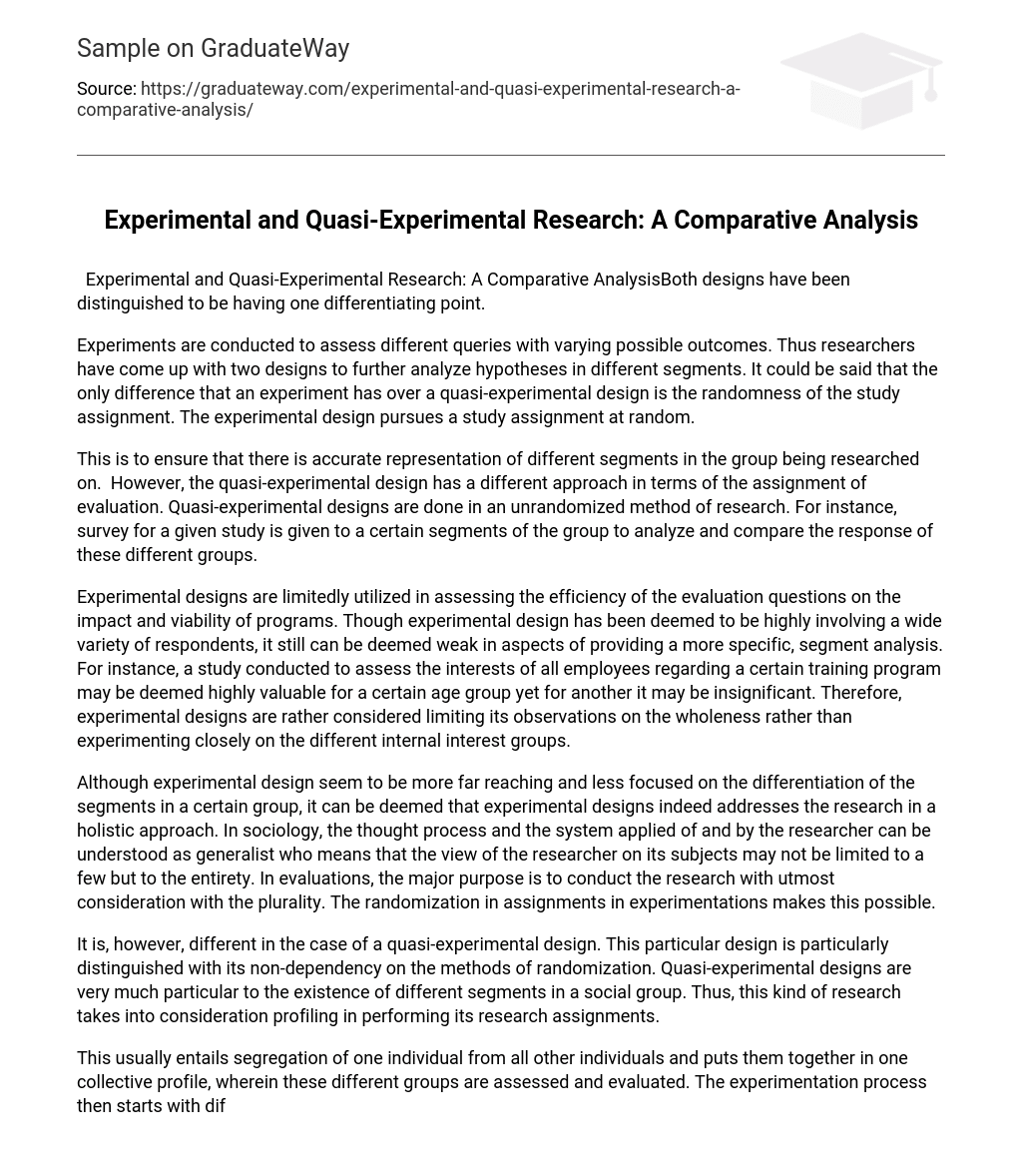Experiments are conducted to assess different queries with varying possible outcomes. Thus researchers have come up with two designs to further analyze hypotheses in different segments. It could be said that the only difference that an experiment has over a quasi-experimental design is the randomness of the study assignment. The experimental design pursues a study assignment at random.
This is to ensure that there is accurate representation of different segments in the group being researched on. However, the quasi-experimental design has a different approach in terms of the assignment of evaluation. Quasi-experimental designs are done in an unrandomized method of research. For instance, survey for a given study is given to a certain segments of the group to analyze and compare the response of these different groups.
Experimental designs are limitedly utilized in assessing the efficiency of the evaluation questions on the impact and viability of programs. Though experimental design has been deemed to be highly involving a wide variety of respondents, it still can be deemed weak in aspects of providing a more specific, segment analysis. For instance, a study conducted to assess the interests of all employees regarding a certain training program may be deemed highly valuable for a certain age group yet for another it may be insignificant. Therefore, experimental designs are rather considered limiting its observations on the wholeness rather than experimenting closely on the different internal interest groups.
Although experimental design seem to be more far reaching and less focused on the differentiation of the segments in a certain group, it can be deemed that experimental designs indeed addresses the research in a holistic approach. In sociology, the thought process and the system applied of and by the researcher can be understood as generalist who means that the view of the researcher on its subjects may not be limited to a few but to the entirety. In evaluations, the major purpose is to conduct the research with utmost consideration with the plurality. The randomization in assignments in experimentations makes this possible.
It is, however, different in the case of a quasi-experimental design. This particular design is particularly distinguished with its non-dependency on the methods of randomization. Quasi-experimental designs are very much particular to the existence of different segments in a social group. Thus, this kind of research takes into consideration profiling in performing its research assignments.
This usually entails segregation of one individual from all other individuals and puts them together in one collective profile, wherein these different groups are assessed and evaluated. The experimentation process then starts with different processes. For this specific design, methods such as time series, non-equivalent, and pretest-posttest designs are utilized.The methods correlated to the quasi-experimental designs have a common classifying factor; time.
Quasi-experimental designs integrate time in its process as there are needed periods for every research to be completed efficiently. For instance, a certain group will be analyzed for a certain period of time to be compared with another corresponding group. Thereafter, the evaluations are analyzed and another set of test are done to distinguish the accuracy of the first experiment. The researchers then create groundwork on the differences of the first experimentation to the latter and come up with probable conclusions on the possible inaccuracies that were gathered in the first interpretation.
This periodic research in quasi-experimentation furthers the credibility of the said design.This kind of time dependent research somehow provides a higher level of accuracy for the experimentation. If comparisons are made between the methods of experimentation and quasi-experimentation, there would be different levels of considerations in its very analysis. For one, experimentation does not involve effortful repetitions of experimentation to establish the researches’ credibility.
This by itself showcases the very strength of an experimental design through its viability with time saving efforts. The experiment concludes immediately the credibility of the tasks assigned because of its concept of randomization. As stated earlier in this research, experimentation deals with various respondents without taking into consideration any kind of profiling. Thus, there are no immediate biases that are detected in the course of the research which, biases which often heightens the experiment’s margin of error.
Although time efficiency is highly advantageous, it cannot be denied that accuracy of research should be the utmost priority in experimentation. Quasi-experimentation takes accuracy seriously as its methods include systematic detection of probable errors from initial testing by the conduction of a series of experimentation that vividly identifies probable miscalculations and biases within the research.In conclusion, both experimentation and quasi-experimentation have its advantages and disadvantages in the field of research. However, both designs should be understood as mutually exclusive.
Experimentations should be done in several researches, and quasi-experimentation on the other hand has its own set of probable researches. It is however fitting those researchers is wary on all these advantages as to properly utilize the correct design to be used for their respective researches involving experiment methods such as these.
Reference
- Broota, K. (1989). Experimental Design in Beahvioral Research.
- New Age International.Cohen L. Morrison Keith, & Manion L. (2003).
- Research Methods in Education. Routledge 5th ed.Glatthorn, A. & Joyner, R (2005).
- Writing the best thesis or dissertation. Corwin Press.Sapsford, R.& Jupp, V. (2006). Data Collection and Analysis. SAGE.





